DIY Large Concrete Stepping Stones Shaped Like Natural Stone

Make natural looking DIY concrete stepping stones or pavers. Color the concrete and mold it into the shape of real fieldstones or flagstones.
Finally, the DIY Concrete Stepping Stones are finished. It’s a project I wanted to do last year because when we moved into this rental home, we quickly decided that we wouldn’t use the front door to go in and out of the house. Why?
Because the existing path from the driveway to the door was 6” deep with pebbles. To walk on it, I kid you not, was like walking in quicksand or even like walking in deep water. Someone didn’t have their thinking cap on when they made that path. ;0)
Video For Natural Looking DIY Concrete Stepping Stones
**If you love doing concrete and cement projects, you may want to check out the article I did on Concrete and Cement Crafts Mixes where I compared the differences. There you can also download my Free Pocket Guide To The Mixes. 
So I decided I’d make stepping stones that would look like real fieldstone, using concrete of course. It’s a cheaper alternative to the real thing and for me, required less prep work with the ground because the concrete is self-leveling. You’ll still have to level the top, but it may not be necessary for you to do anything to level the ground beforehand.
You’ll need to figure out how much mix you will need for your concrete stepping stones project. I used Quikrete’s online calculator before the project, but it didn’t end up being accurate, so the calculator is probably worth skipping.
To simplify my quantities, I figured I had the equivalent of 9 large stepping stones. Technically I had 5 large ones, but if I combined the small ones together, I could see that they would have made 9 large ones. By “large”, I mean approximately 3’ x 2’ and they were approximately 2” thick.
Each stone used a little less than a full bag, and I think the existing pebbles that were already in the ground took up some of the space so I needed slightly less than you may need so at the same size, it’s safe to calculate 1 bag per large 3’ x 2’ stepping stone.
So how do you know how many stones you will need for your chosen path location? First I sketched out how I wanted them to look. Then I was able to get a pretty good idea by using ropes as temporary molds. I placed pieces of rope onto the path and wrapped the rope into the shapes and sizes I planned my stones to be. These basically acted as templates.
This method made it easy to see that I would have a mix of 5 large stones and several small stones – again, which if combined, would make 9 large stones. If you purchase the bags of concrete mix through a big box store, they are returnable, so I recommend buying 1 more bag than you think you’ll need.
For my reusable concrete mold, I used vinyl chair strapping. These straps are what are the replacement straps used to repair those vinyl strap outdoor chairs. There may be a cheaper alternative, such as vertical vinyl slats.
In addition to reading the tutorial, I highly recommend watching my video as well before you make these. Some of the steps and techniques I used, especially for molding and coloring are a bit difficult to explain in writing and even photos. Use this written tutorial as a supplement to the video.
My main goal with these stones was to make them look just like natural fieldstones. I wanted the shape to look natural, as well as the coloring. Now fieldstones come in many sizes, shapes and colors, so what is natural looking to me, may not be natural looking to you.
You may want to do a Google image search on fieldstones or flagstones to see which ones float your boat.
When it comes to color, it’s important to know that this Sand Topping Mix cures to a frosted pale grey- almost a frosted white. I actually included this Sand Topping Mix in my Cement Tests post where I compared the colors of various cement mixes.
Even in my tests, the concrete cured to a frosty grey/white, but for some reason, when I made these concrete stepping stones, I didn’t think the color of the stones would turn out light like the bowl in my tests did.
This was the shade of grey I had intended on.
I must have thought that maybe because the stones were so large, they would naturally turn out a more medium grey. I was wrong. Just be aware that when the cement is wet, it looks quite dark, but will cure to quite a light shade of grey that almost looks white.
So to avoid having any surprises with color, I strongly recommend that you make two test pieces before starting this stepping stones project. You don’t need to use your vinyl straps, just plop your wet mixture onto the ground where your stones will go and make them into any shape.
Make one test piece that is approximately 1’x1’ and 2” deep. Test the coloring by brushing the colorant on top of one side of the colorant and leave the other side natural for comparison.
On the second test stone- this one can be 6 x 6” and 2” deep, but add charcoal colorant into the mix- rather than brushing it on. This will give you a sense of how the techniques work and whether you need to adjust the amount of colorant. For a 6 x 6” piece, half a tablespoon (if using the liquid colorant) should be your starting point.
Please refer to COLORING THE BASE LAYER- just before Step 5, as well as Steps 5 & 6 for detailed instructions on coloring to make the test pieces.
Let these test pieces cure a minimum of 3 days -a week is better. This will show you what you have to work with. You don’t want to end up having to buy expensive stains or dyes, along with etching products and sealants, to correct the color if the color isn’t what you were going for.
This will save you time and money by doing some testing first.
Again, don’t let this scare you from the project, the stones are easy to make and ridiculously fun to color. You also will have plenty of time to adjust the color as you are working on them.
Really the issue is just having an understanding of how much lighter they will look when fully cured.
PREP THE SPACE
Now that you have a good understanding of the coloring, you can prep the space.
I didn’t have too much prep to do for this path. The path was already there but was covered in pebbles, so I shoveled all the loose pebbles out the areas I would be placing the stones.
The ground was very unlevel but I didn’t worry about leveling because I knew the concrete would self-level to some extent, plus I didn’t mind if they weren’t perfectly level. You can always do the leveling at the top of the concrete stones.
PUT TOGETHER THE STEPPING STONE MOLD
Use tape to join the ends of the vinyl straps together. Depending on the size, I sometimes overlapped the straps rather than butting the ends into each other.
Toward the end of my stone making, I skipped taping the ends together because the mold held its shape in part because I was able to push some extra pebbles up against the sides. I even started pulling the mold off right away. It’s up to you and how comfortable you feel.
Take the garden stakes and push them into the ground around the outside of your mold wherever you feel it needs support. These are what you will manipulate to get the general stone shape.
MIX THE CONCRETE
Using the hoe, mix the concrete with water. It will be easier and less dusty if you first add some water to your mixing bin or wheelbarrow. Then pour in the dry concrete mix -but do this in small batches. If you try to do it all at once, it will make it very difficult to mix in such a large amount.
Mix the concrete and adjust by adding more water or concrete until you get a peanut butter-like consistency. It will probably be easiest if you mix what you think you’ll need for the whole stone, but separate a section that will be the top ½”, but don’t color it yet, you’ll do this after the base layer is in place.
CAST THE CONCRETE STEPPING STONE MOLDS
**For another cool outdoor project, you may want to check out my Vertical Cinder Block Planter Wall.
My methods evolved over time. I finally decided that just dumping the concrete into the mold was the best way to go. If this is easiest for you then go ahead and just pour it directly into the mold. Otherwise, you might find it easier to use a shovel to place the concrete.
Only pour in the mix that is reserved for the 1 ½” base layer. Spread the concrete around with your gloved hands first, and be sure to get it right up to the strap edges.
Next, use the trowel to level the concrete. Keep the trowel at a slight angle and just sweep it back and forth.
COLORING THE BASE LAYER
Now go ahead and add the charcoal colorant to the remaining mix you had separated and mix it in well. The amount you add will have been determined from the two pieces you tested before beginning the project.
Once the coloring looks even, pour it on top of the base layer. Use the trowel again to get it level and smooth. Hold off on applying the brush on color for now. Your timing will be more efficient if you start your next stepping stone.
Since I did most of this project by myself, I found it was easiest to go mix another batch and set up the next mold, pour it and lightly level it, and then come back to the previous mold and remove the strap.
The reason for my timing on this is because the concrete will have started setting and will be moldable enough- that should be in about 15-25 minutes.
Your workability time (the time before it becomes too difficult to mold or add colorant) for these stepping stones should be about an hour, depending on climate conditions.
After you have started the next stone mold, feel the concrete to see if it has some form to it. If so, then remove the vinyl strap. Now use your gloved hand to shape the edges. Round them a little, and push them inward to create more of a curve if you want. You may also want to slant to the edge.
Now you will want the following supplies near the stone you are coloring. Plastic bags; a coarse paintbrush; a small bucket of water; a rag for clean up and various colorants of your choice, along with a bowl or cup for each.
In addition, for each color you have, you should also have one cup of water, plus you may find it helpful to have one more extra cup of water.
Pour some of each colorant into its own bowl/cup. If your pigment is a powder, then mix some water in with it. Place the extra bowl/cup of water next to each color.
Accent coloring the stones is kind of like painting watercolors, they require lots of blending. This is why you have extra cups of water. The small bucket of water will be for cleaning up the brush and your hands.
The main colors I used for this brush-on coloring technique were charcoal, red and a little blue.
ARTISTIC/ACCENT COLORING OF THE TOP LAYER
Take the coarse paintbrush and dip it into the first color and then into the water. Apply this in a brushing motion to the stone where you want to add color. Blend it in and just play with it. If you are using red, then go lightly with it because it tends to be highly pigmented and you only need a little to get the color to come through.
Blend these colors into the stone and into each other the way you might with a watercolor painting. You can dip your brush back into the water to help with blending. Don’t forget to get the edges. You can play with this by adding water to help mute the color.
ADD STONE TEXTURE TO THE CONCRETE
Now you will use the plastic bag to achieve two things, one is to blend the colors more and the other is to create the stone-like texture. Place the bag on your hands and pat the top of the concrete. Keep patting until you like the way the texture and blending look.
LET THE CONCRETE STEPPING STONES CURE
Now continue these steps with the rest of the stones. Technically, the stones will reach their full cure in 3-4 weeks- meaning their full strength. I was able to carefully walk on them after about 24 hours, but you should wait 3-5 days before you allow any foot traffic.
If you are wondering about needing to cover these with plastic while curing, per the concrete representative at Quikrete, it is not necessary. You also do not need to water cure these.
I had my concrete covered because it was the height of pollen season and I didn’t want the yellow pollen staining the stones. I only left the plastic on for one day. They were dry enough that I wasn’t worried about color permeating them.
SEAL THE CONCRETE STONES -RECOMMENDED
I didn’t seal these -in part because I didn’t want to add an extra expense for a home I don’t own. They are porous, so you will likely encounter staining if you don’t seal them. One month post-project I can see stains from berries and other foliage, and when scrubbing them, some of the stains go away, but not all of them. It would also help protect against fading.
Look for an outdoor concrete or stone sealer. And be sure you do a test patch first to make sure it doesn’t change the color or darken the concrete stones in any undesired way.
Enjoyed the project?
Resources for this project:
See all materials
Comments
Join the conversation
-
 Emilie DeWolf
on Aug 12, 2023
Emilie DeWolf
on Aug 12, 2023
Can't wait to try this.. the gravel is all ready down... What fun this will be❤️
Thank you
.
-
-
-



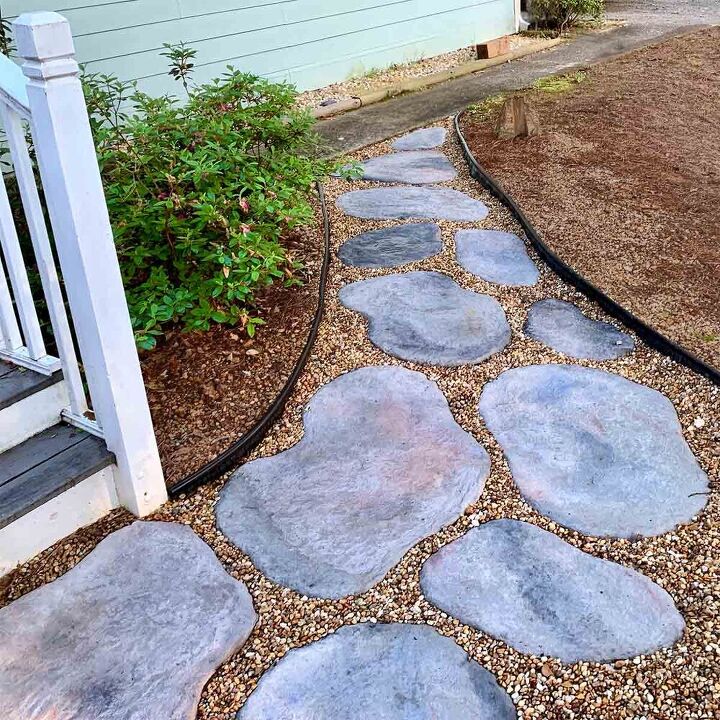


























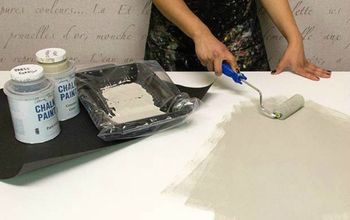
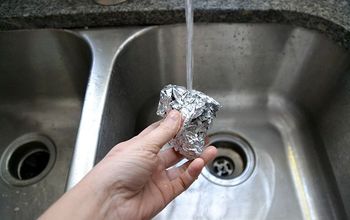



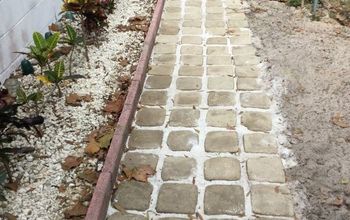
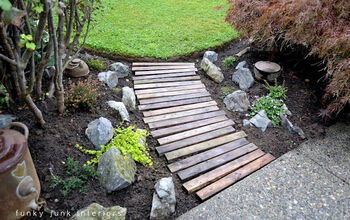
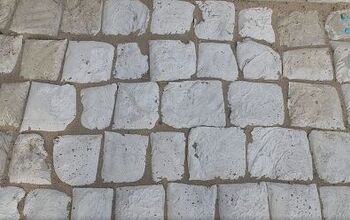
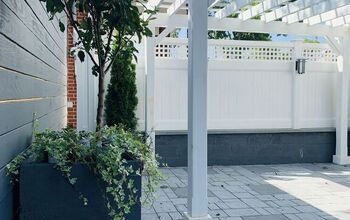
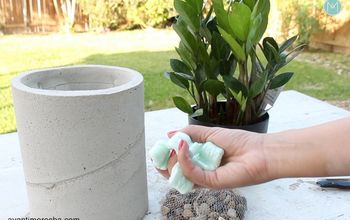
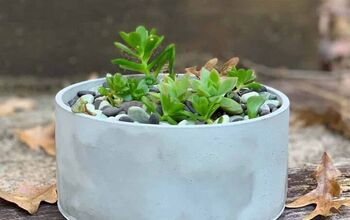
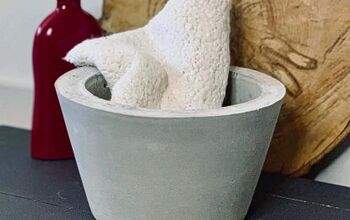
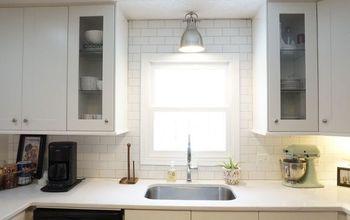
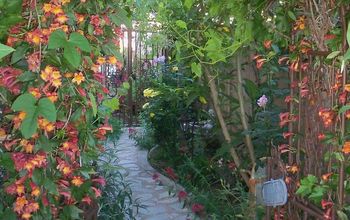
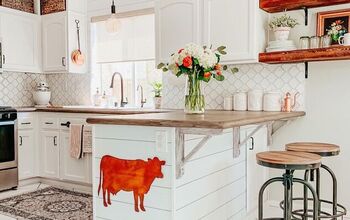
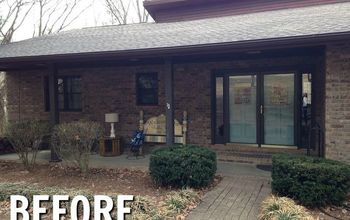
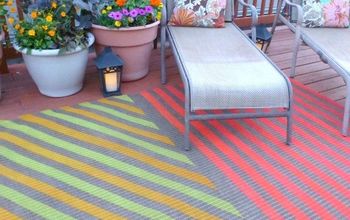
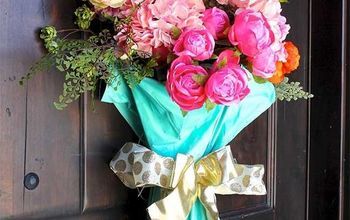
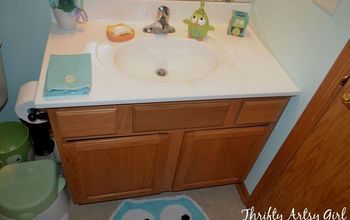
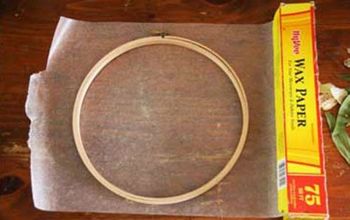
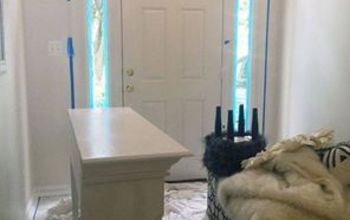
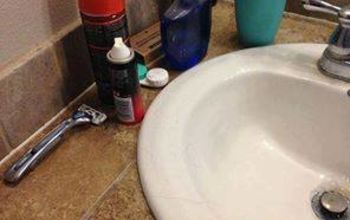
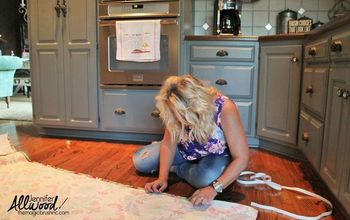
Frequently asked questions
Have a question about this project?
Wow. So many of the articles in here are quick fix and I have my doubts if they will last for a week. This tutorial was very well thought out mapped out, illustrated and overall done really well. Nicely done
Shouldn’t rebar or something be added so the stones don’t crack when walked on?
what kind of paint did you use